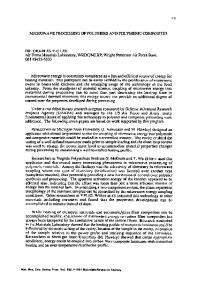Biomedical Polymers Synthesis and Processing
This book presents a comprehensive review on the various processing and post-processing methodologies for biodegradable polymers. Written by professionals with hands-on experience on polymer processing, this book provides first-hand knowledge of all conte
- PDF / 3,171,858 Bytes
- 79 Pages / 439.37 x 666.142 pts Page_size
- 108 Downloads / 409 Views
Vinod B. Damodaran Divya Bhatnagar N. Sanjeeva Murthy
Biomedical Polymers Synthesis and Processing 123
SpringerBriefs in Applied Sciences and Technology
More information about this series at http://www.springer.com/series/8884
Vinod B. Damodaran Divya Bhatnagar N. Sanjeeva Murthy •
Biomedical Polymers Synthesis and Processing
123
Vinod B. Damodaran New Jersey Center for Biomaterials Rutgers—The State University of New Jersey Piscataway, NJ USA
N. Sanjeeva Murthy New Jersey Center for Biomaterials Rutgers—The State University of New Jersey Piscataway, NJ USA
Divya Bhatnagar New Jersey Center for Biomaterials Rutgers—The State University of New Jersey Piscataway, NJ USA
ISSN 2191-530X ISSN 2191-5318 (electronic) SpringerBriefs in Applied Sciences and Technology ISBN 978-3-319-32051-9 ISBN 978-3-319-32053-3 (eBook) DOI 10.1007/978-3-319-32053-3 Library of Congress Control Number: 2016939573 © The Author(s) 2016 This work is subject to copyright. All rights are reserved by the Publisher, whether the whole or part of the material is concerned, specifically the rights of translation, reprinting, reuse of illustrations, recitation, broadcasting, reproduction on microfilms or in any other physical way, and transmission or information storage and retrieval, electronic adaptation, computer software, or by similar or dissimilar methodology now known or hereafter developed. The use of general descriptive names, registered names, trademarks, service marks, etc. in this publication does not imply, even in the absence of a specific statement, that such names are exempt from the relevant protective laws and regulations and therefore free for general use. The publisher, the authors and the editors are safe to assume that the advice and information in this book are believed to be true and accurate at the date of publication. Neither the publisher nor the authors or the editors give a warranty, express or implied, with respect to the material contained herein or for any errors or omissions that may have been made. Printed on acid-free paper This Springer imprint is published by Springer Nature The registered company is Springer International Publishing AG Switzerland
Preface
Biomaterials have been used from ancient times starting with the use of wound closure devices in Egypt in 2000 BC and transplantation of bones from animals to humans in India in 1000 BC. Until recently, commonly available materials such as steel, silk, and nylon were adapted for medical applications. Only in the late twentieth century, especially since the 1970s starting with the efforts of Robert Langer at MIT, materials began to be engineered specifically for biomedical applications. These include special ceramics and metals for load-bearing application such as bone, tooth, and hip implants, and plastics (or polymers) for non-load-bearing, flexible devices. While polymers are inherently softer than metal and ceramics, they can be made to have strengths approaching those of bones. In addition, recent development in functionalization of the polymers
Data Loading...











